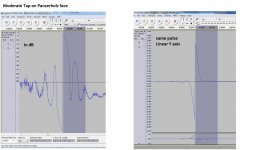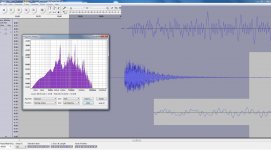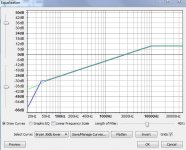Johnnog,
I wasn't entirely sure of what you were proposing. I assume MU 25 is similar to Panzerholz. True?
So far, I haven't found anything does much to improve Panzerholz, except more Panzerholz and some viscous material. E.g. My 20mm sheet of P'holz sounds a bit lively. When I added an 8mm piece and some ductseal, it gave it much more dead sound.
It'll be a while before I actually try it as a plinth.
Hugh
I wasn't entirely sure of what you were proposing. I assume MU 25 is similar to Panzerholz. True?
So far, I haven't found anything does much to improve Panzerholz, except more Panzerholz and some viscous material. E.g. My 20mm sheet of P'holz sounds a bit lively. When I added an 8mm piece and some ductseal, it gave it much more dead sound.
It'll be a while before I actually try it as a plinth.
Hugh
I should re-read before I hit "submit". That should say..
So far, I haven't found anything that does much to improve Panzerholz, except....
So far, I haven't found anything that does much to improve Panzerholz, except....
Cats Squirrel,
Good idea!🙂
I found that one of the headaches is coping with all the harmonics and modulation. One of the screen grabs is a piece of 5 inch square steel. I also tried a round one (not shown here) and found it was much easier to interpret.
I've also attached a test on a stiff piece of Vinyl flooring 100 mm in diameter. Practically textbook waveform. Do you agree with the DF of 0.1 ?
The last shot is a 100mm Diameter x 16mm thick piece of Panzerholz. Is this the waveform I should be looking for? If so, does DF of 0.5 look right?
Thanks,
Hugh
Hi Hugh,
first up, look at the vinyl tile waveform with dB scale. Notice that the highest peak is not linearly related to the later peaks, so I would disregard it. The next highest and the next one after that provide the answer. However, from your calculations, it looks like you have calculated the damping ratio, rather than the damping factor. No worries, as damping factor = 2 x damping ratio.
I measured the peaks of interest from your graphic and calculated the damping factor to be 0.142. This agrees favourably with a vinyl tile I measured a long time ago at 0.145.
Regarding the steel panel (plate). There seems to be a lot of noise. Any ideas why? do you do any software filtering? Do you correct for the CR filters on the accelerometer board. Can you post a graph of the filter you use to compensate for the loss of higher frequencies from the CR filters?
There is something wrong with your Panzerholz waveform. What was the resonance frequency?
Hi Hugh
MU 25 has approx 15% increase in weight over a Birch Plywood per Cubic Metre.
P'holz is almost double the weight of Birch Plywood per Cubic Metre.
MU 25 was a got to material when P'holz was gaining popularity for Plinths.
My Plinth has been supplied by a P'holz > TT Owner who has the same TT and Tonearm as mine.
I get the opportunity periodically to listen to the TT in P'holz and will once more visit the home this coming Friday, HooRah for a Relaxation on the COVID Travel and Meet Restrictions.
Only when I have a P'holz material at home will I fully be able to notice any impact on the presentation from the TT.
It is easier to pick up on the differences in the Two Systems and not on the Plinth ,Materials in use.
MU 25 has approx 15% increase in weight over a Birch Plywood per Cubic Metre.
P'holz is almost double the weight of Birch Plywood per Cubic Metre.
MU 25 was a got to material when P'holz was gaining popularity for Plinths.
My Plinth has been supplied by a P'holz > TT Owner who has the same TT and Tonearm as mine.
I get the opportunity periodically to listen to the TT in P'holz and will once more visit the home this coming Friday, HooRah for a Relaxation on the COVID Travel and Meet Restrictions.
Only when I have a P'holz material at home will I fully be able to notice any impact on the presentation from the TT.
It is easier to pick up on the differences in the Two Systems and not on the Plinth ,Materials in use.
DF vs DR
Cat's Squirrel,
That one revelation - DF vs DR clears up many mysteries in one shot.
So, the 100mm Vinyl piece is now my reference for everything else.
Q: If I increase the diameter, but same thickness, should the DF stay the same?
I'll do a couple of other posts on the Steel and the Panzerholz.
Thanks!!!
Hugh
However, from your calculations, it looks like you have calculated the damping ratio, rather than the damping factor. No worries, as damping factor = 2 x damping ratio.
I measured the peaks of interest from your graphic and calculated the damping factor to be 0.142. This agrees favourably with a vinyl tile I measured a long time ago at 0.145.
Cat's Squirrel,
That one revelation - DF vs DR clears up many mysteries in one shot.
So, the 100mm Vinyl piece is now my reference for everything else.
Q: If I increase the diameter, but same thickness, should the DF stay the same?
I'll do a couple of other posts on the Steel and the Panzerholz.
Thanks!!!
Hugh
There is something wrong with your Panzerholz waveform. What was the resonance frequency?
Cats Squirrel,
I'd say the resonance was about 1000 hz. 2 cycles take about 0.002 seconds. Here's another jpeg of that same impact with scaling in db, then linear.
It seems that with a very light tap, I get an even smaller pulse with no ringing at all.
If I go slightly harder, it rings at a higher frequency - 5 khz. I've uploaded an example of this. Is it any good? I get a very, very low DF from this one.
Do you have a good example of typical Panzerholz damping that you could post? It may be easier if I have an idea from that.
Hugh
Attachments
Regarding the steel panel (plate). There seems to be a lot of noise. Any ideas why? do you do any software filtering? Do you correct for the CR filters on the accelerometer board. Can you post a graph of the filter you use to compensate for the loss of higher frequencies from the CR filters?
Here's the graphics for the Equalization. It should be 30db less than what you recommended (unless I got sloppy again). I don't think the literature for the two Accelerometer boards I have actually say what's in them for RC filters. I'm just assuming it's the typical 50 hz corner frequency.
I should have posted different levels of zoom for that 5x5" steel piece, so here's another picture with a few extra pastes. Lots of modulation. It was a very thin, light piece. I'm think the mass of the accelerometer was enough to muck up the resonances.
A heavier, round piece gave much cleaner results. Vinyl and Acrylic even better.
Hugh
Attachments
Cat's Squirrel,
That one revelation - DF vs DR clears up many mysteries in one shot.
So, the 100mm Vinyl piece is now my reference for everything else.
Q: If I increase the diameter, but same thickness, should the DF stay the same?
I'll do a couple of other posts on the Steel and the Panzerholz.
Thanks!!!
Hugh
Hi Hugh,
damping factor is an intrinsic property, as is density. This means that it doesn't matter how much there is of a material, the answer is always the same! So it doesn't matter if we measure a 1 cm cube of steel, or a whole ship, the density will be the same (assuming the same steel, and only steel!).
The problem with using round samples of a material is that of ringing, that is, self reinforcement of resonances.The resonances leave the point of excitement, and travel around the sample in two directions, producing a complex (modulated) waveform. Use a sample of material which is square, or better still, rectangular, and of a mass that is at least 10x that of the accelerometer.
Here is my equalisation graph:
 equalization accelerometer by cats squirrel
equalization accelerometer by cats squirrelJust remind me why you are using -30dB. My accelerometer feeds into my sound card (M-Audio Audiophile 24/96 Rev B). I still think there is a lot of noise on your traces.
Last edited:
Cats Squirrel,
Earlier on, when I equalized, I got the red clipping marks on some signals. This doesn't seem to be an issue with everything reduced by 30 db. Audacity is in 32 bit mode, so I'm hopefully not loosing any resolution.
If a signal ends up getting too small, the "Amplify" feature does a nice job at bringing it up to a usable level without clipping. Sometimes it's just a few db. Soemtimes as much as 12 dB.
Hugh
Earlier on, when I equalized, I got the red clipping marks on some signals. This doesn't seem to be an issue with everything reduced by 30 db. Audacity is in 32 bit mode, so I'm hopefully not loosing any resolution.
If a signal ends up getting too small, the "Amplify" feature does a nice job at bringing it up to a usable level without clipping. Sometimes it's just a few db. Soemtimes as much as 12 dB.
Hugh
Have you tried isolating the resonance frequency with high/low filters? The last trace you show has a 300 Hz peak. Apply a high then a low pass filter at 300Hz and 24 dB/Oct. It should clean up the waveform no end. The filters are in 'Effect' (top left of screen) and in the 'Plug-ins 1 - 15' . You may have to load these yourself.
I should add...
I'm using a so-so soundcard that's built into an old PC. It may very well not be the best for noise.
I'm not too concerned with the steel measurements, but maybe the Panzerholz ones would benefit from a different PC.
Thanks,
Hugh
I'm using a so-so soundcard that's built into an old PC. It may very well not be the best for noise.
I'm not too concerned with the steel measurements, but maybe the Panzerholz ones would benefit from a different PC.
Thanks,
Hugh
Have you tried isolating the resonance frequency with high/low filters? The last trace you show has a 300 Hz peak. Apply a high then a low pass filter at 300Hz and 24 dB/Oct. It should clean up the waveform no end. The filters are in 'Effect' (top left of screen) and in the 'Plug-ins 1 - 15' . You may have to load these yourself.
I've not tried that. It sounds like I should.
Thx.
Have you tried isolating the resonance frequency with high/low filters? The last trace you show has a 300 Hz peak. Apply a high then a low pass filter at 300Hz and 24 dB/Oct. It should clean up the waveform no end. The filters are in 'Effect' (top left of screen) and in the 'Plug-ins 1 - 15' . You may have to load these yourself.
I'm likely using a different version of Audacity (2.1.0). It has a notch filter, low pass etc. so I tried some of them on the 5x5 Steel data . It does clean up the waveform.
Hugh
I should add...
I'm using a so-so sound card that's built into an old PC. It may very well not be the best for noise.
I'm not too concerned with the steel measurements, but maybe the Panzerholz ones would benefit from a different PC.
Thanks,
Hugh
my computer is probably older, but has had three mother boards, 4 sound cards and numerous HD drives. My Audacity is a 2.1.2, but I run a Linux variant.
The work I did on the Panzerholz sample was over a decade ago, and the sample was sent to me, the sender needed the sample back. The data was on an old HD, and as I have moved house twice since then the data could be anywhere!
Last edited:
Yikes. That's a shame he couldn't let you keep the sample. If you'd like another 100 mm x 100 mm x 20 mm square one to keep, I'd be glad send it.
And, if any of the latest Panzer pics I posted earlier strike you as being valid ( or even remotely on the right track) I'd appreciate hearing it.
If the present crop of Panzerholz is not damped like the sample you had, I'll be trying other measures.
Hugh
If the present crop of Panzerholz is not damped like the sample you had, I'll be trying other measures.
Hugh
Yikes. That's a shame he couldn't let you keep the sample. If you'd like another 100 mm x 100 mm x 20 mm square one to keep, I'd be glad send it.
That would be really useful. If you could measure it before you sent it, and tell me which accelerometer you use, we could compare results.
I'll send you my Address by PM.
To be fair to the guy who wanted his Panzerholz back, it was only one of several he sent (of other materials) and all of which pushed plinth building to the heights of what it can be, today.
Thanks again
Last edited:
Also, please disregard those Panzerholz pics. I think I just noticed a dumb mistake in the EQ filter on that PC.
If cats sqirrel has not got the sample, and the data on P'holz is produced from approx'
10 Years ago, it might be worth trying to investigate if B15 or B25 were both available as a product from this period of time.
B25 has more Teirs of Wood to make up the Board, each Teir on B25 is belived to be a thinner layer than used on a B15 Board.
The differences in the laminations used for each of the productions might influence a test result ?
10 Years ago, it might be worth trying to investigate if B15 or B25 were both available as a product from this period of time.
B25 has more Teirs of Wood to make up the Board, each Teir on B25 is belived to be a thinner layer than used on a B15 Board.
The differences in the laminations used for each of the productions might influence a test result ?
- Home
- Source & Line
- Analogue Source
- DIY CLD Plinth Design--A measured Approach



